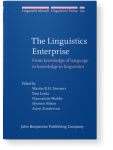Catching heffalumps
Onset fricatives in child speech
This paper argues that a seemingly cognitive phenomenon, that of imitation in early child speech (the parroting of a model by the child), when approached in a formal manner, can provide unexpected insight into the nature of the developing grammar. With the help of a large corpus of – in principle – spontaneous speech of a single Dutch speaking child, it shows that it is highly rewarding to make a distinction between child utterances that are apparent direct imitations of a model, and unprompted utterances. A detailed discussion of empirical material illustrating the phenomenon of onset fricative avoidance leads to the conclusion that mere imitation is not just sparroting, but is directly conditioned by the ambient grammar. The framework of Optimality Theory is used to demonstrate how, given a child grammar in which generally speaking markedness constraints precede faithfulness constraints, this finding can be formalised in terms of typically premature high-ranking faithfulness triggered by an imitation context. It is also shown that the formalisation of the analysis in terms of ranked constraints is compatible with independent O.T. theorising about the nature and development of early grammars.
